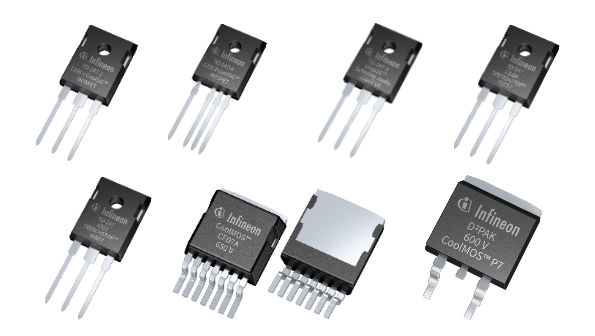Single-phase hybrid inverter solutions

Climate concerns and geopolitical instability are driving demand for energy self-consumption. Photovoltaic (PV) provides an accessible way to achieve such energy independence by making energy generation and consumption possible at home. However, traditional string or microinverters cannot address the need for energy storage. This is where hybrid inverters come in.
Hybrid inverters open up new doors for self-consumption, while reducing the amount of materials, space, and complexity needed to build PV systems. Not only are they designed to connect multiple PV panels and convert the generated DC current to AC, they can also supply DC currents directly to an Energy Storage System (ESS) like a battery. By integrating the ESS component, hybrid inverters eliminate unnecessary power conversions and thus, reduce losses.
Infineon offers a wide range of solutions for your single-phase hybrid inverter – from power and sensing, to control and connectivity.
Several main topologies are used in the power stages of single-phase hybrid inverters. First, the DC-DC stage converts variable DC voltage into a fixed DC voltage while simultaneously ensuring maximum power is extracted from the PV panel through a MPPT (Maximum Power Point Tracking) technique. In general, simple boost topology is preferred in this stage.
Next, the DC-DC stage enables bi-directional energy transfer between the battery and the DC bus. In general, for high-voltage batteries, non-isolated bi-directional DC-DC converters are preferred, and for low-voltage batteries, isolated bi-directional DC-DC converters are used.
Finally, the DC-AC stage converts DC power into grid-compatible AC power. Either 2-level or innovative topologies like HERIC, H6, and Multilevel are preferred in this stage. HERIC and H6 topology are more suitable for single-phase hybrid inverter designs due to their higher efficiency. The size and weight of the inverter highly depend on the filter inductor size (DC & AC) and cooling system (housing), so a higher switching operation is desirable to reduce the size and cost of the system.
Infineon offerings for designs up to 6 kW
Infineon offers a wide range of solutions for single-phase hybrid inverters. Usually, these inverters are rated from around a few kilowatts to up to 6 kW. Infineon’s discrete IGBTs, MOSFETs, CoolSiC™ MOSFETs, and CoolSiCTM Schottky diodes are the prefered choice to achieve the best price to performance ratio.
All switches need a driver, and all drivers need to be controlled. We also offer the right EiceDRIVER™ gate driver, as well as the XMC™ and PSoC™ microcontroller for your inverter design. Finally, each functional block needs a sensor and auxiliary power supply, so we offer our CoolSET™ and the TLI4971 current sensor. A smart combination to address connectivity is provided by the AIROC™ family, which offers a Bluetooth and WiFi in a single device. OPTIGA™ products complete the portfolio and ensure data protection and security.
In particular, additional power conversion block demands higher conversion efficiency. Being battery application, improvements in conversion efficiency shall reduce the battery capacity and its associated battery cost. More over these inverters are installed inside residential spaces, so inverter design has to enable fan-less operation within small form factor. This is highly challenging requirements, which demands low conversion losses at higher switching frequency operation. Therefore, manufacturers are focusing on both efficiency & power density improvement, In particular partial load efficiency is of high importance to further improve the performance of the system.
Best-in class hybrid inverters must be efficient, power dense, and compact. Wide bandgap technologies like Silicon Carbide enable inverter to switch faster than before with significantly low conversion losses. This increased efficiency can reduce battery capacity and enable fanless designs. Such features make a big difference in residential and commercial installations, where quieter, smaller systems are required. And ultimately, they reduce the amount of materials needed to build lighter and efficient hybrid inverter.
Trends and requirements of single-phase hybrid inverters
In particular, additional power conversion block demands higher conversion efficiency. Being battery application, improvements in conversion efficiency shall reduce the battery capacity and its associated battery cost. More over these inverters are installed inside residential spaces, so inverter design has to enable fan-less operation within small form factor. This is highly challenging requirements, which demands low conversion losses at higher switching frequency operation. Therefore, manufacturers are focusing on both efficiency & power density improvement, In particular partial load efficiency is of high importance to further improve the performance of the system.
Best-in class hybrid inverters must be efficient, power dense, and compact. Wide bandgap technologies like Silicon Carbide enable inverter to switch faster than before with significantly low conversion losses. This increased efficiency can reduce battery capacity and enable fanless designs. Such features make a big difference in residential and commercial installations, where quieter, smaller systems are required. And ultimately, they reduce the amount of materials needed to build lighter and efficient hybrid inverter.
Webinars
Solar and Energy Storage Systems (ESS) are crucial in the energy supply chain. This webinar gives an overview of solar and ESS trends and discusses the importance of residential solar and ESS for renewable decentral energy generation. It will also discuss the different architectures of home energy systems and how Silicon Carbide (SiC) and Gallium Nitride (GaN) can improve performance in various power conversion stages to meet future application trends.












